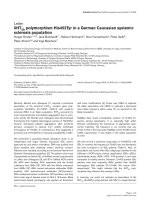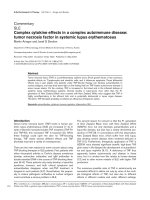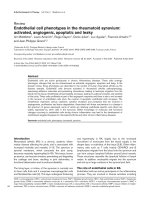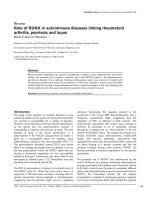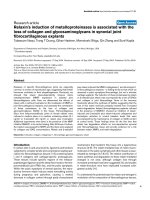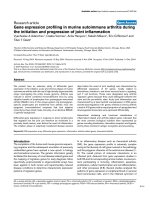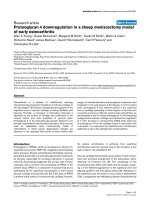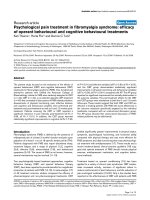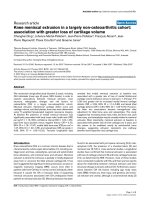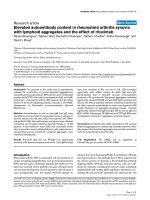Báo cáo y học: "Benign gastro-colic fistula in a woman presenting with weight loss and intermittent vomiting: a case report" pps
Bạn đang xem bản rút gọn của tài liệu. Xem và tải ngay bản đầy đủ của tài liệu tại đây (1.43 MB, 3 trang )
CAS E REP O R T Open Access
Benign gastro-colic fistula in a woman presenting
with weight loss and intermittent vomiting: a
case report
Kate Barrett
*
, Michael W Hii and Richard J Cade
Abstract
Introduction: Benign gastro-colic fistula is a rare occurrence in modern surgery due to the progress in medical
management of gastric ulcer disease. Here we report the first case of benign gastro-colic fistula occurring whilst on
proton-pump inhibitor therapy. This is a case study of benign gastro-colic fistula and review of the available
literature in regards to etiology, diagnosis, management and prognosis.
Case presentation: An 84-year-old woman of Caucasian background presented with 12 months of worsening
abdominal pain, nausea, vomiting, diarrhea and weight loss on a background of known gastric ulcer disease.
Conclusion: The leading cause of gastro-c olic fistulae has changed from benign to malignant due to improved
medical management of gastric ulcer disease. The rarity and non-specific symptoms of gastro-colic fistula make the
diagnosis difficult and it is best made by barium enema; however, computed tomography has not been formally
evaluated. Surgical management with en bloc resection of the fistula tract is the preferred treatment. Benign
gastro-colic fistulae are becoming exceedingly rare in the context of m odern medical management of gastric ulcer
disease. Surgical management is the gold standard for both benign and malignant dis ease.
Introduction
Gastro-colic fistulae are described as presenting with the
clinical triad of diar rhea, nausea/vomiting and weight
loss [1]. However, all three features are said to occur in
only 30% of patients. Other symptoms include malnutri-
tion with cachexia, anemia, abdominal pain and fecal
halitosis that is present in over 50% of patients [1,2].
Malignant gastro-colic fistulae were first described in
1755 by Haller [3]. Gastro-colic fistulae due to benign
peptic ulcer disease were describ ed by Firth in 1920 [4].
Gastrointestinal malignant disease is the predominant
cause today: colonic adenocarcinoma in the Western
world, gastric carcinoma predominating in Japan [2,5].
Other malignant causes include gastric lymphoma, carci-
noid tumors of the colon and lo cally invasive m alignant
tumors of the biliary tree, pancreas and duodenum [1].
Benign causes described include peptic ulcer, gastric
tuberculosis, trauma, syphilis, retroperitoneal sarcoma,
Crohn’s disease and pancreatitis [2,3].
The overall incidence of gastro-colic fistula has
decreased since the advent of effective medical manage-
ment of gastric ulcer disease. Post-surgical-resect ion-
associated fistulae and fistulae related to the use of
non-steroidal anti-inflammatory medications were the
most reported causes of be nign gastro-colic fistulae
[2,4,6]. In a single case series from 1955, prior to the
advent of H2 antagonists and proton pump inhibitors, it
was reported that up t o 10% of patients post-gastrect-
omy for benign gastric ulcer subsequently developed a
gastro-colic fistula [7]. Fistulae in gastric ulcer disease
in the setting of proton pump inhib itor use are excee d-
inglyrareandtothebestofourknowledgethisisthe
first documented case.
A barium enema is t he radiological modality of choice
for diagnosis of gastro-colic fistulae, with specificity of 90-
100% compared with a barium meal that has a false nega-
tive rate of 30-70% [1,3]. Endoscopic investigations are
recommended to exclude malignant disease. Computed
tomography (CT) has not been evaluated for sensitivity
and specificity but has been reported in one case series as
a useful adjunct in diagnosis and staging.
* Correspondence:
St Vincent’s Hospital Melbourne, PO Box 2900 Fitzroy, Victoria 3065, Australia
Barrett et al. Journal of Medical Case Reports 2011, 5:313
/>JOURNAL OF MEDICAL
CASE REPORTS
© 2011 Barrett et al; licensee BioMed Central Ltd. This is an Open Access article di stributed under the terms of the Creative Commons
Attribution License ( nses/by/2.0), which permits unrestricted use, dis tribution, and reproduction in
any medium, provided the original work is properl y cited.
The treatment of choice for a gastro-colic fistula is en
bloc surgical resection of the fistula tract with a margin
of adjacent tissue [1,3,4,8]. This allows disease free mar-
gins in malignant disease and decreases the recurrence
rate in benign disease, which has been reported to be up
to 12%. The recurrence rate is higher if simple excision
of the fistula tract is used for initial management [1].
Several cases of medical or minimally invasive man-
agement of gastro-colic fistulae have been described and
may be suitable where malignant disease has been
excluded and/or surgical intervention is not appropriate.
Endoscopic injection of the fistula tract with fibrin has
shown to be effective in several case reports [1].
Prognosis for gastro-colic fistula has been thought to
be quite poor. Between 1963 and 1994, the longest
recorded survival post-resection for gastro-colic fistula
due to malignant disease was nine to ten years [1,5].
Post-operative mortality has be en reported to be as high
as 25%, presumably due to co-morbidity and de-condi-
tioning of the patients [1].
One case series of six patients reported one post-
operative death due to underlying co-morbid co nditions.
The remaining cases were followed for a mean of 66
months, with one further death due to an unrelated
underlying co-morbid condition [1]. However, there
have been very few recent studies and advances in surgi-
cal techniques and post-operative care a s well as nutri-
tional optimization suggest empirically that prognosis
may have improved.
Case presentation
An 84-year-old Caucasian woman presented for repeat
gastroscopy for follow-up of a benign gastric ulcer. She
gave a 12-month history of worsening abdominal pain,
nausea, non-feculent vomiting, diarrhea and approxi-
mately 20 kilogram weight loss. She denied any hema-
temesis, melena or fever. At presentation our patient
was frail and emaciated. Regarding clinical examination,
there were no abnormal abdominal findings.
A chronic gastric ulcer on the greater curve of her sto-
mach had been first diagnosed at gastroscopy eighteen
months earlier. Since then she had undergone four further
gastroscopies without any change. Biopsies had only
demonstrated features of chronic inflammatory change.
Helicobacter pylori had never been identified. Our patient
was taking aspirin for cardiovascular prophylaxis and had
been started on pantoprazole at 40 milligrams twice daily
when t he ulcer was first identified. Our patient’s general
practitioner confirmed prescription requests for this
medication.
On this occasion, gastroscopy revealed a deep ulcer of
the greater curve o f the stomach that appeared to pene-
trate the muscular layer and was highly suspicious of a
fistula. The pathological report of the performed biopsy
showed chronic inflammatory changes. An abdominal
CT demonstrated a fistula between the stomach and
transverse colon and excluded malignant d isease. Con-
trast CT successfully diagnosed a fistula, excluded
locally invasive disease and allowed pre-operative plan-
ning in a single step. A colonoscopy showed no evi-
dence of primary colonic disease and failed to visualize
the fistulous opening (Figure 1).
At laparotomy there were dense adhesions betwe en
thegreatercurveofthestomachandthedistaltrans-
verse colon. The gastric ulcer together with the fistulous
track and colonic opening were excised en bloc and pri-
mary anastomoses performed as malignant disease could
not be definitely ruled out. A feeding jejunostomy wa s
performed (Figures 2, 3, 4). Histopathology showed
chronic inflammatory changes consistent with gastric
ulceration. No malignancy was identified.
Our patient was discharged to a peripheral hospital on
the twentieth post-operative day tolerating an oral diet.
Conclusion
A gastro-colic fistula commonly presents with non-spe-
cific symptoms of diarrhea, nausea and vomiting and
weight loss, thus making it a difficult diagnosis. The rar-
ity of this condition, and alteration in the underlying
etiology due to the advent of medical management o f
gastric ulcer disease, make benign gastro-colic fistula a
very rare diagnosis. This case is important as it
Figure 1 Coronal CT scan post-gastroscopy revealing gastro-
colic fistula demonstrated by oral contrast in the stomach and
distal transverse colon and absence of contrast in the
duodenum. There are associated inflammatory changes around the
transverse colon.
Barrett et al. Journal of Medical Case Reports 2011, 5:313
/>Page 2 of 3
highlights the non-specific presentation of the disorder
and is the first case documented in which benign gastric
ulcer disease treated with proton-pump inhibitors pro-
gressed to gastro-colic fistula.
Consent
Written informed consent was obtained from the patient
for publicatio n of this case report and any accompany-
ing images. A copy of the written c onsent is available
for review by the Editor-in-Chief of this journal.
Authors’ contributions
MH and RC were the surgeons involved in the care of the patient. KB
researched the background management of the patient and performed the
literature review. All authors read and approved the final manuscript.
Competing interests
The authors declare that they have no competing interests.
Received: 5 January 2011 Accepted: 14 July 2011
Published: 14 July 2011
References
1. Aydin U, Yazici P, Ozutemiz O, Guler A: Outcomes in the management of
gastrocolic fistulas; a single unit’s experience. Turk J Gastroenterol 2008,
19(3):152-157.
2. Buyukberber M, Gulsen M, Sevinc A, Koruk M, Sari I: Gastrocolic fistula
secondary to gastric diffuse large B-cell lymphoma in a patient with
pulmonary tuberculosis. J Nat Med Assoc 2009, 101(1):81-83.
3. Coughlin G, Willings R, Hamilton D: Gastro-colic fistula complicating
benign gastric ulcer in analgesic abusers. Aust N Z J Med 1979,
9(3):314-315.
4. Forshaw M, Dastur J: Long-term survival from gastrocolic fistula
secondary to adenocarcinoma of the transverse colon. World J Surg
Oncol 2005, 3(1):9.
5. Marschall J, Bigsby R, Nechala R: Gastrocolic fistulae as a consequence of
benign gastric ulcer disease. Can J Gastroenterol 2003, 17(7):441-443.
6. Suazo-Barahomna J, Gallegos J, Carmona-Sanzhez R: Non-steroidal anti-
inflammatory drugs and gastrocolic fistula. J Clin Gastroenterol 1998,
26(4):343-345.
7. Rhind J: Gastro-jejuno-colic fistula. Lancet 1955, 269(6902):1225-1227.
8. McCullough M, Gregson R: A case report: spontaneous healing of a
gastro-colic fistula due to a benign gastric ulcer. Clin Radiol 1987,
38(4):431-433.
doi:10.1186/1752-1947-5-313
Cite this article as: Barrett et al.: Benign gastro-colic fistula in a woman
presenting with weight loss and intermittent vomiting: a case report.
Journal of Medical Case Reports 2011 5:313.
Submit your next manuscript to BioMed Central
and take full advantage of:
• Convenient online submission
• Thorough peer review
• No space constraints or color figure charges
• Immediate publication on acceptance
• Inclusion in PubMed, CAS, Scopus and Google Scholar
• Research which is freely available for redistribution
Submit your manuscript at
www.biomedcentral.com/submit
Figure 2 The operative field showing the stomach attached to
omentum and transverse colon.
Figure 3 The operative field demonstrating the stomach
attached to the transverse colon.
Figure 4 En bloc surgical resection of the distal stomach,
transverse colon and surrounding inflammatory tissue.
Barrett et al. Journal of Medical Case Reports 2011, 5:313
/>Page 3 of 3
